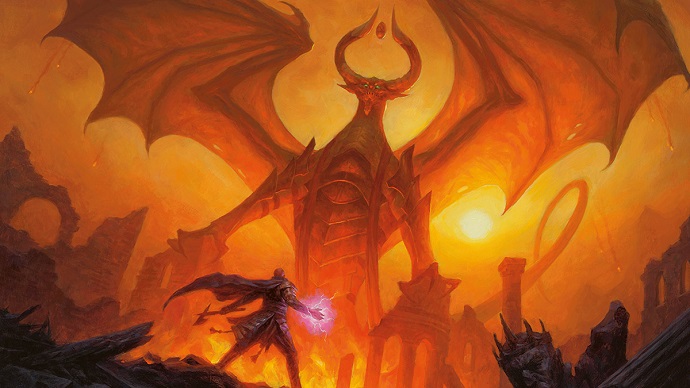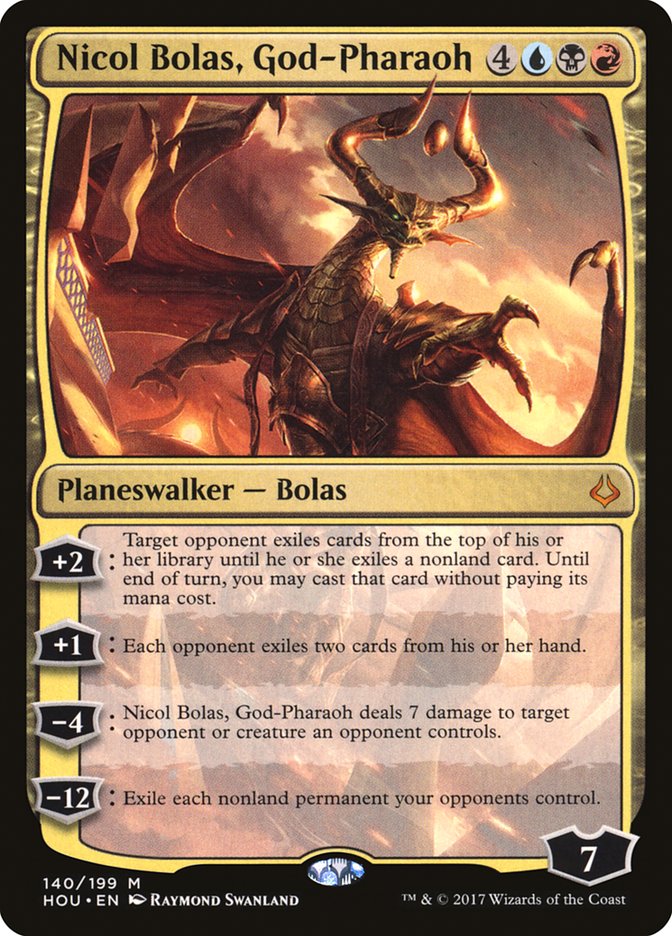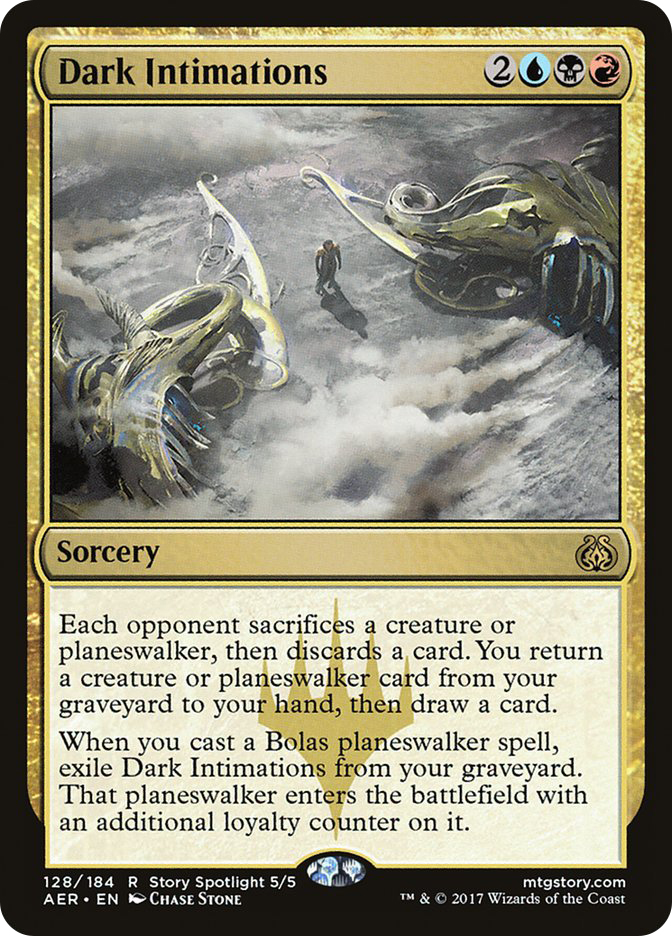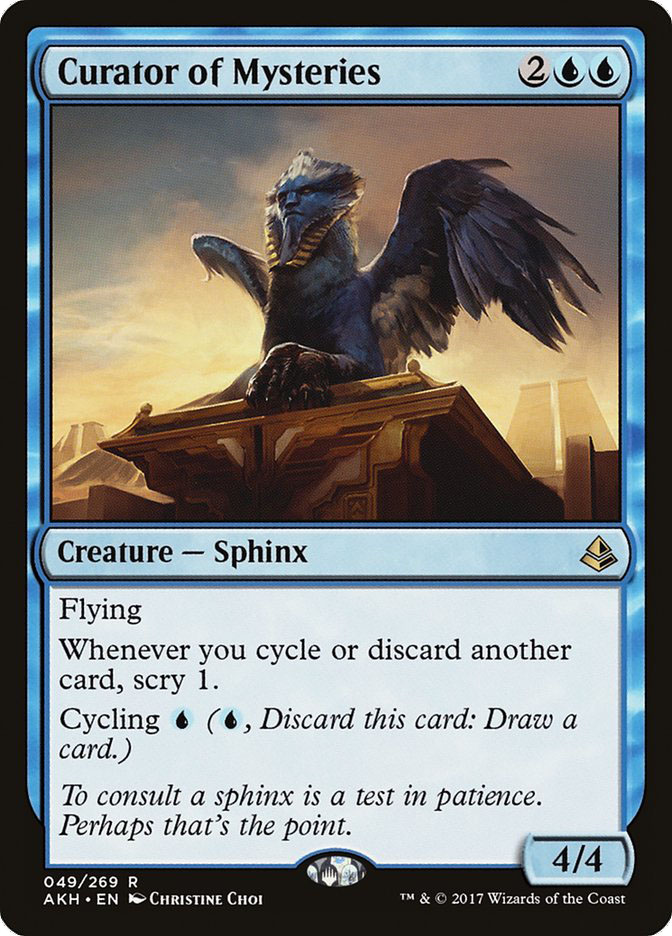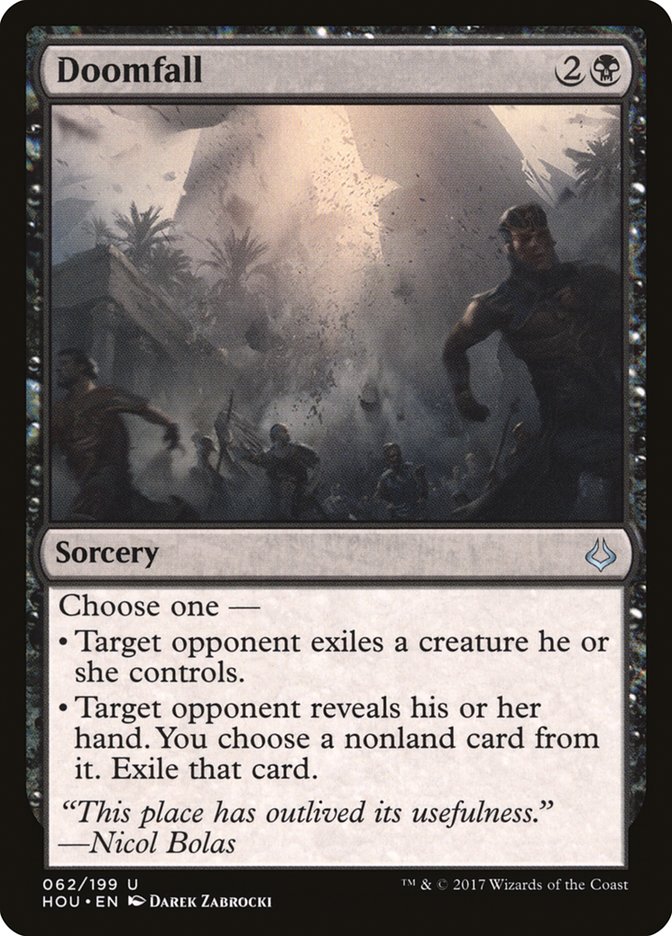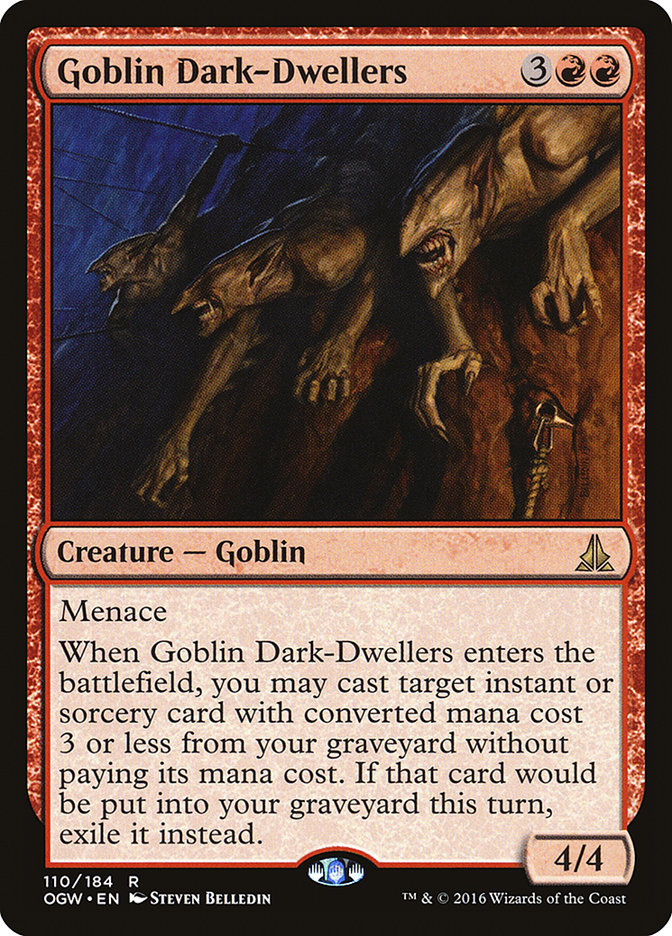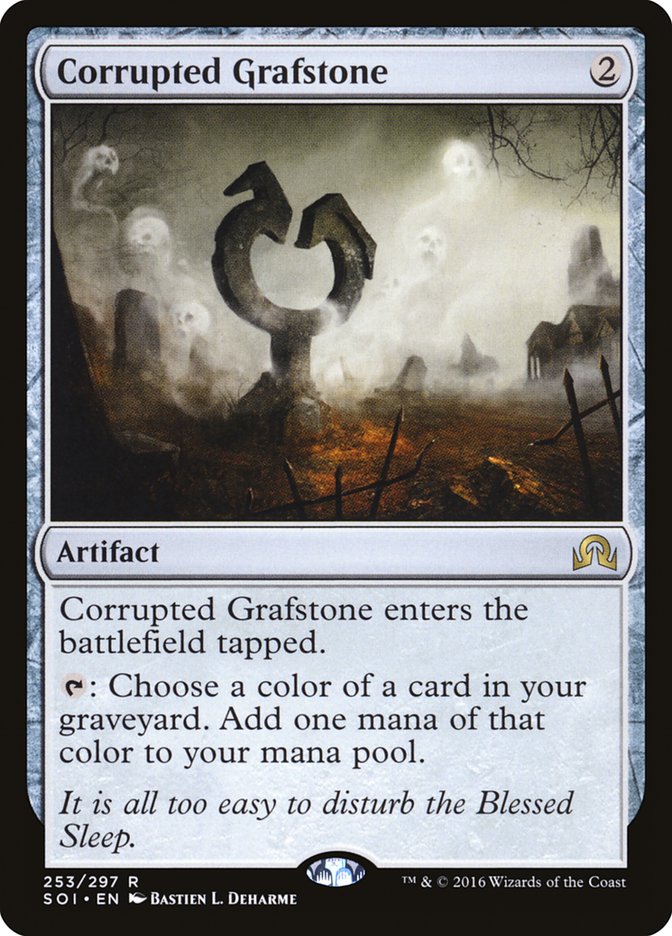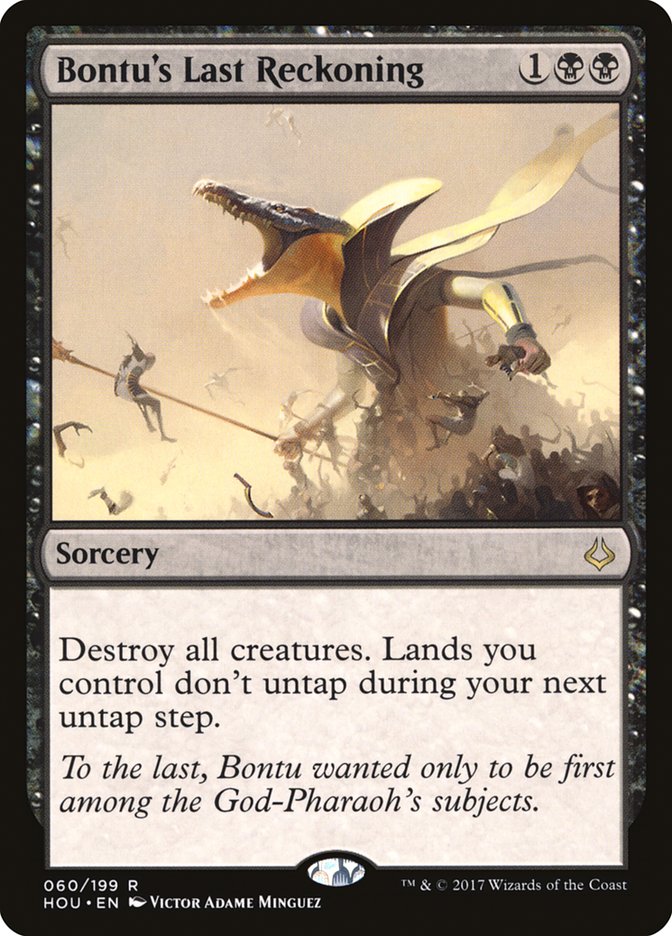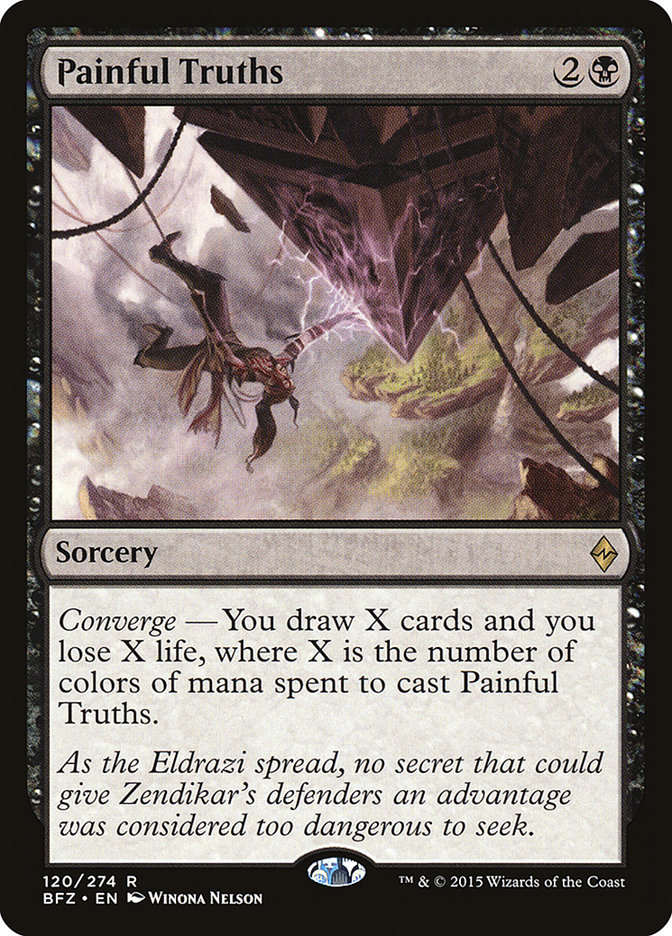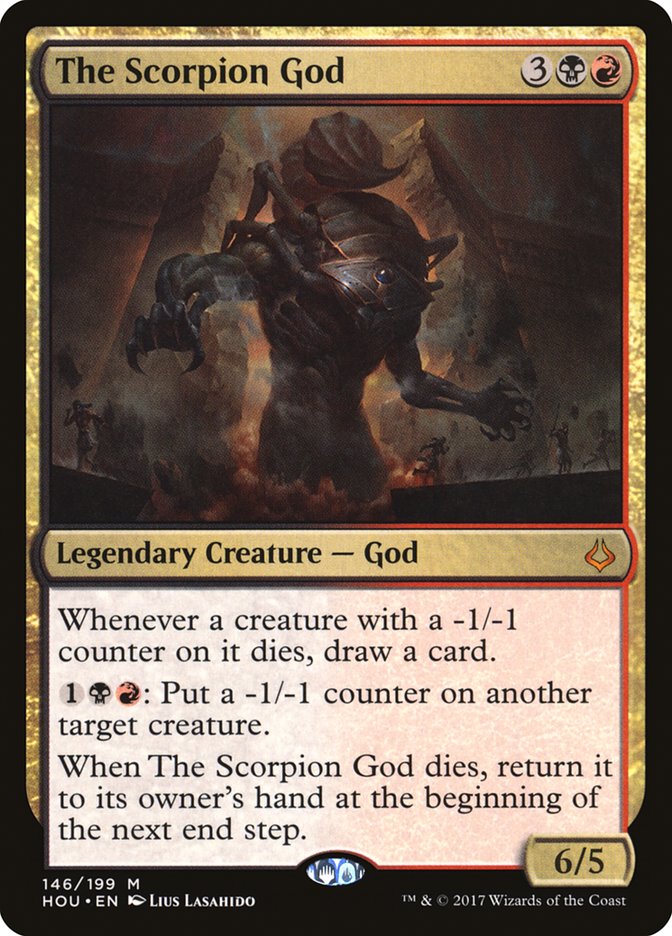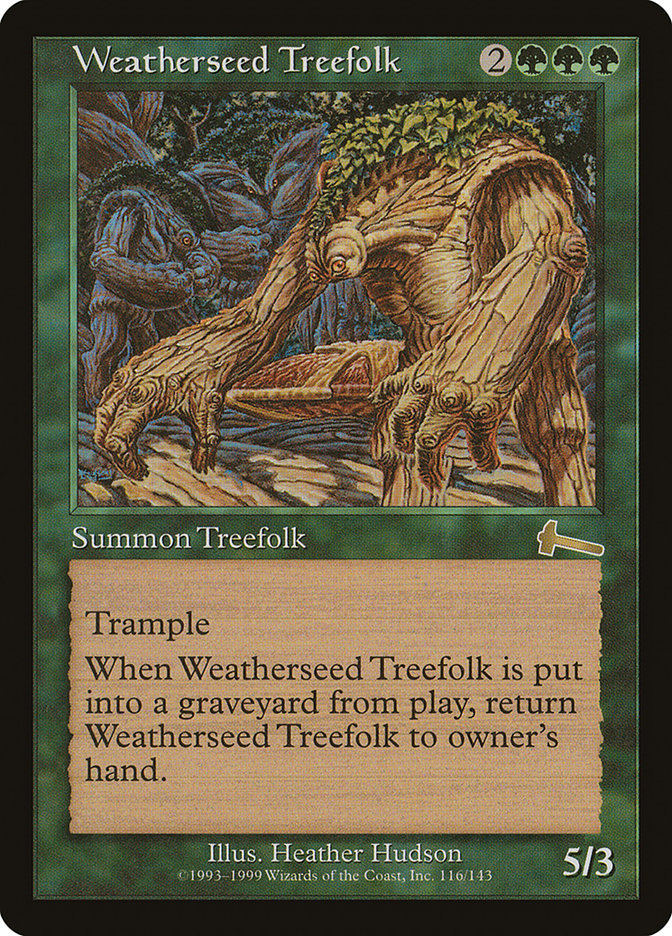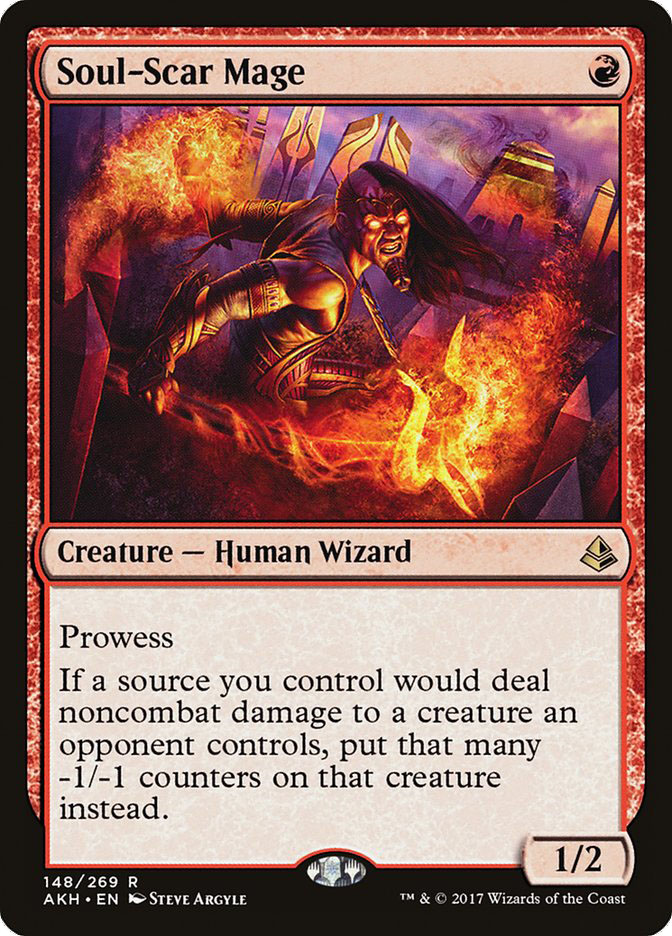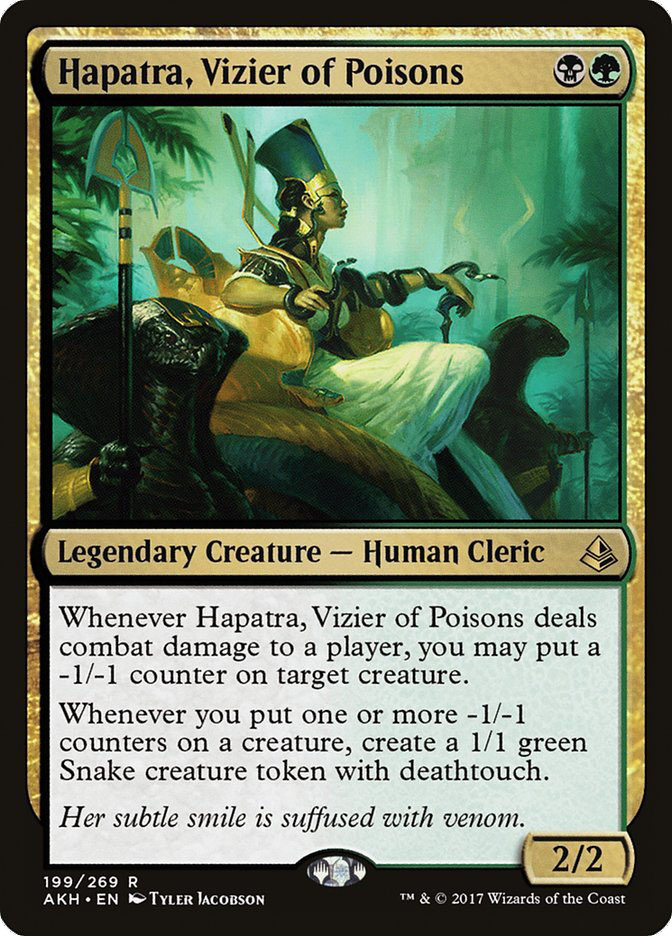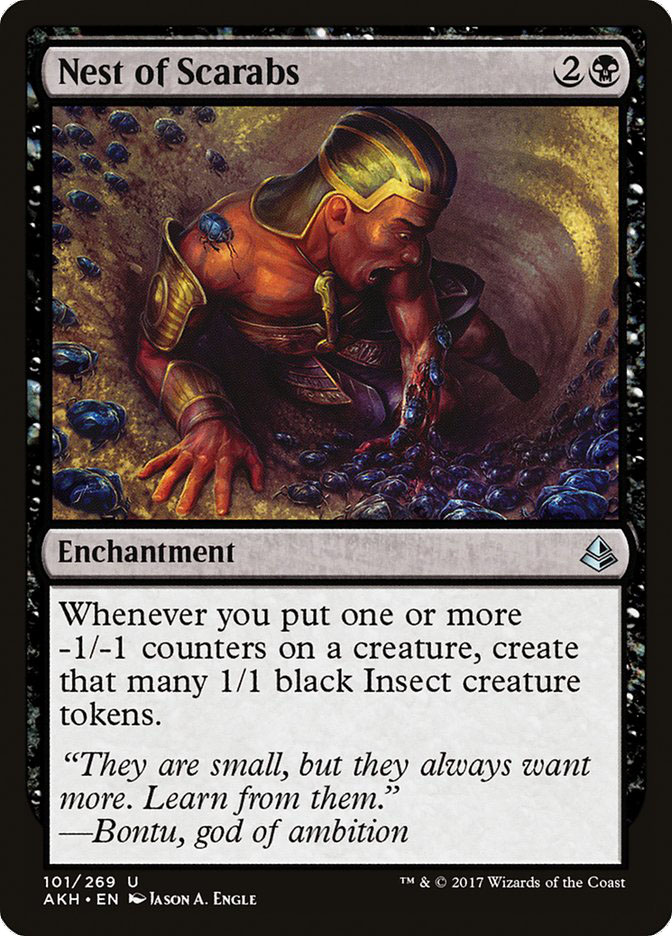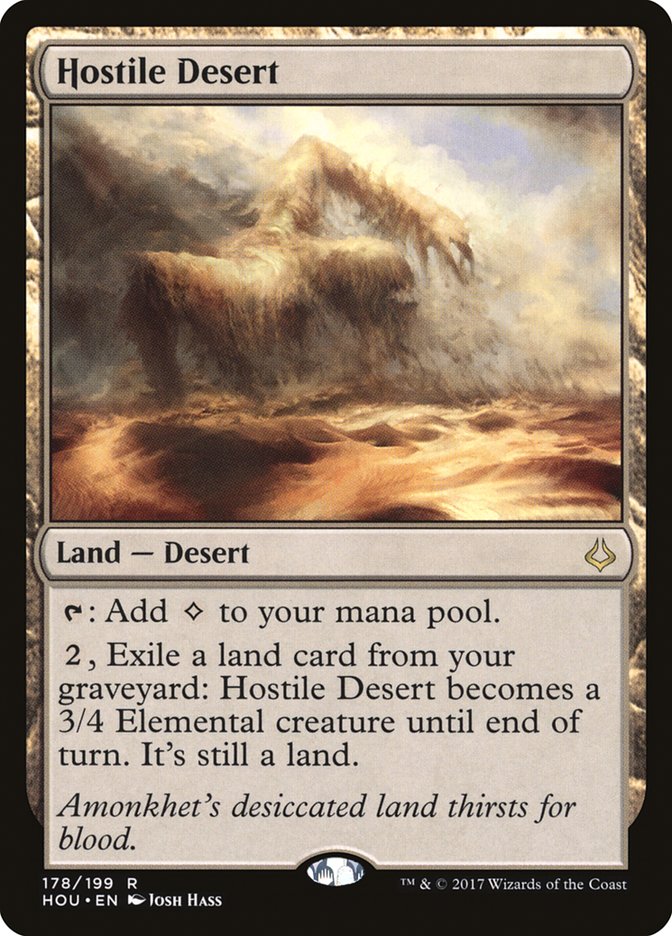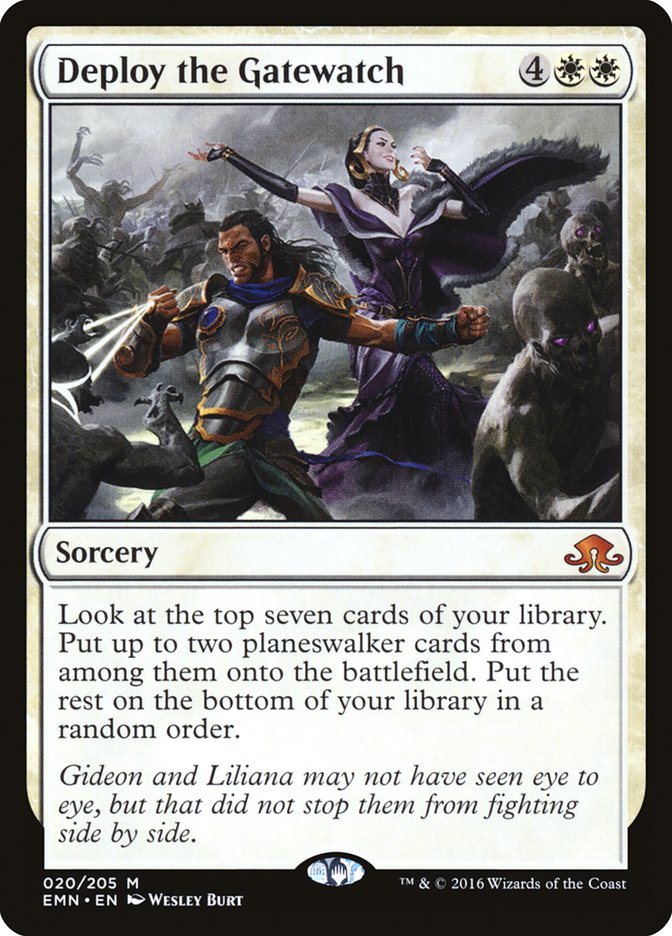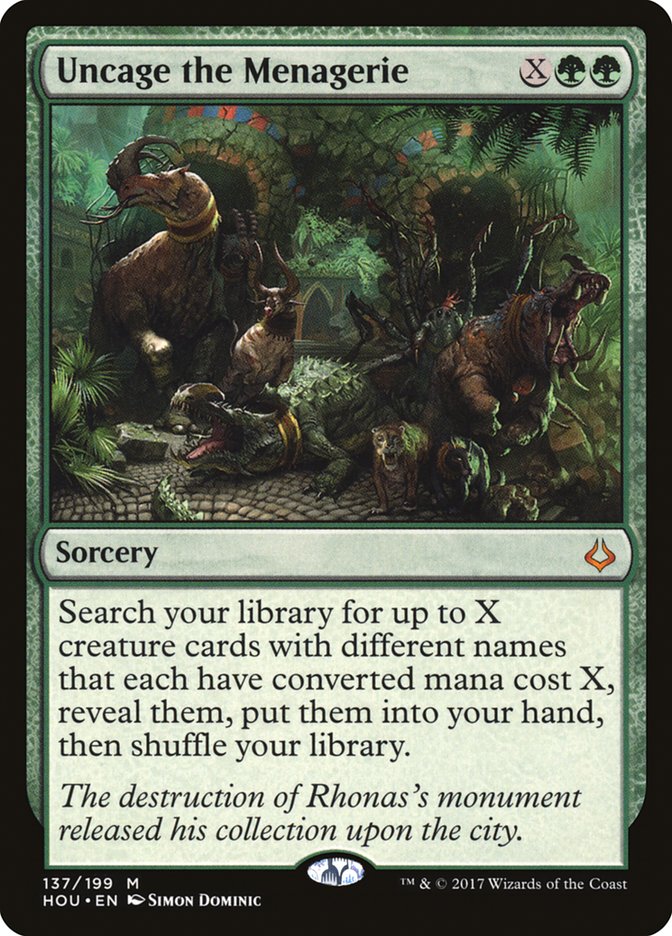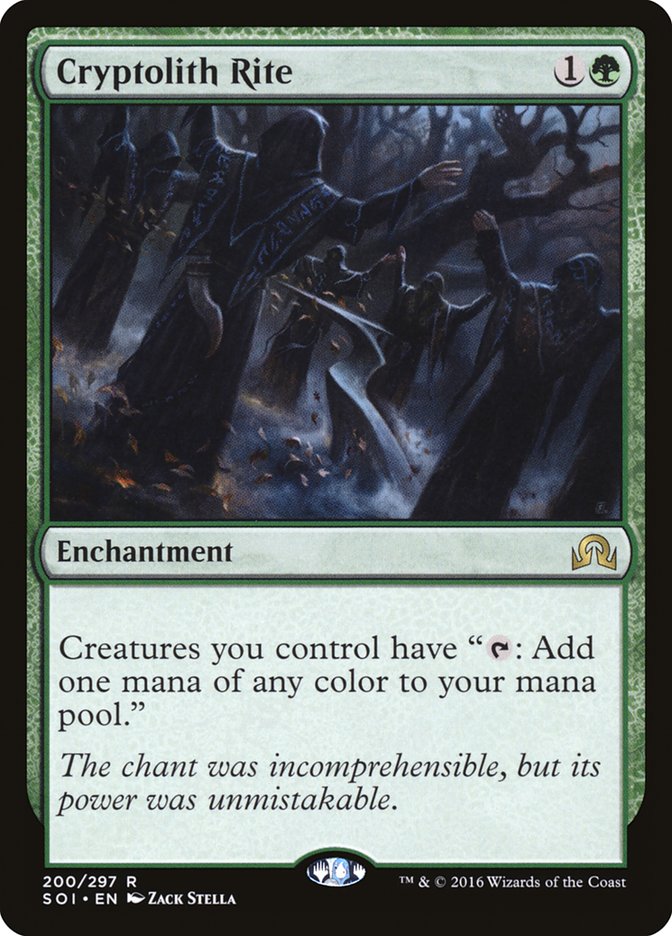Last week on “What’s Happening in Standard,” our enemies, the Gatewatch, were soundly defeated. It was a glorious battle, though one with a predictable outcome. Our God-Pharaoh has returned.
There’s a lot to unpack with the new Nicol Bolas, and, as with most planeswalkers, we should start with the minus ability you can use when you first cast him. In general, this ability represents the strongest impact you can have on the battlefield if you treat the planeswalker as a spell.
From there, the plus ability gives you an idea of how strong are the options you have (and is frequently the best way to use the card turn-after-turn). The plus ability also informs how big of an impact you can have while you work your way up to the ultimate. Finally, some planeswalkers have ultimates that rarely fire, while for others it’s an important part of the card’s strategy.
So, starting with Bolas’s minus ability:

This is already a very exciting ability. It’s not just that dealing seven damage for seven mana is not a terrible exchange rate (where it’s more mana-efficient than a Fireball). It’s that playing Bolas and activating this ability is effectively:
4UBR
Sorcery
Deal 7 damage to target opponent or creature.
Put a Nicol Bolas Planeswalker onto the battlefield with 3 loyalty.
If your opponent has just one threat (particularly a planeswalker), you can drop Nicol Bolas, kill it, and have an incredible permanent left over. To understand just how good of a permanent, we need to look at the plus ability, or, in Bolas’s case, the plus abilities.

This is an excellent ability, generally worth about two cards. While you are only getting “one card” from the ability, it’s always a spell, which is worth a fair bit more than “having to cast it right now” hurts it. Additionally, it costs you no mana, so it’s like you’re also drawing a Black Lotus each turn.
Now, if you don’t have ways to spend your mana, you may end up wasting it, but, generally speaking, this ability is stronger than basically any other plus ability in the game in terms of value generated. You even get to exile some random cards from your opponent’s deck, making them more likely to deck first and possibly disrupting their deck’s functioning if they were going to be tutoring with cards like Traverse the Ulvenwald. Garruk, Apex Predator’s ability to kill planeswalkers is a pretty impressive plus, but it generally can’t be used turn after turn like Bolas’s +2.

Wow. This ability is such a fantastic complement to the others. The threat alone of this ability is going to warp the way that people play. If you don’t save two cards to pitch to Bolas, you run the risk of your Never//Return or Hour of Revelation being ripped out of your hand (and exiled at that). It’s also another way that Bolas can get two cards of value per turn.
Of course, part of the equation is the ridiculously high starting loyalty of Nicol Bolas, God-Pharaoh. With a seven-loyalty base, using the +2 ability puts you at nine already. There’s a good chance you’ll be able to untap with Bolas even if you brick on the +2 ability. Yeah, a deck with a lot of permission is going to have a lot of misses in it, but you are probably going to be hitting them with the +1 ability most of the time anyway. Most Vehicles aren’t great to reveal to Bolas, though Heart of Kiran is a notable exception.
The following Planeswalker would probably be too strong to print:
2UBR
Planeswalker – Bolas
+2: Target opponent exiles cards from the top of his or her library until they exile a nonland card. Until end of turn, you may cast that card without paying its casting cost.
+1: Each opponent exiles two cards from his or her hand.
-4: Nicol Bolas, God-Pharaoh deals 7 damage to target opponent or creature an opponent controls.
[3]
That’s a really nice Planeswalker to be left with after using the -4 ability, from above. Two different abilities producing about two cards of value? An “ultimate” that is useful and online quickly?
But what about Bolas’s real ultimate?

While not as “instant win” as some planeswalker ultimates, it’s a looming threat the combines extremely well with his other abilities. They will quickly have no hand left and have to keep playing into you, making Bolas’s ultimate all the stronger. Additionally, the nature of his +2 ability leads to some amount of locking up the battlefield. Every turn, you cast a card from your opponent’s deck and they might get to play a card from their deck. You don’t even need to ultimate until you feel like it. You can just keep building up the battlefield, and if things ever start to get out of hand, -12. Besides, you’re still getting to draw cards from your deck!
One interesting wrinkle to all this is this card, right here:
Dark Intimations is quite the little four-for-one.
- They sacrifice a creature or planeswalker.
- They discard a card.
- You return a creature or Planeswalker from your graveyard to your hand.
- You draw a card.
Not only are you getting four cards, you’re getting to convert some of them into useful things like a free Edict and the selection of getting a creature or planeswalker back from your graveyard. The discard is even great for helping set up Bolas so that you can drop him and +1 to remove their counterplay, not to mention any hope they may have had.
Now, there’s a lot of competition at the five-spot in Standard, but Dark Intimations has one more thing going for it: an extra loyalty counter for Nicol Bolas.
How big a deal is a loyalty counter? Well, sometimes it will be wasted for sure: if they Cast Out your Nicol Bolas during your end step, for instance. However, whenever Nicol Bolas survives a situation it would have died, there’s a good chance, that’s a game-winning advantage. What’s more, an extra loyalty counter means Nicol Bolas is threatening to ultimate a turn earlier. Hell, sometimes it’ll be enough to just deal fourteen damage to them over two turns!
Okay, Dark Intimations is sweet, harkening back to the days of Cruel Ultimatum, and now, we’ve finally got our Nicol Bolas. Let’s try our hand:
Creatures (5)
Planeswalkers (5)
Lands (26)
Spells (24)

One of the challenges of utilizing Dark Intimations is needing a creature or planeswalker in the graveyard to get full value. You can cast it without one, but you’re missing out on a free card.
Curator of Mysteries is my favorite of the one-cost cycling creatures. Most of the time we’re just going to be cycling it anyway, but it’s nice to have a somewhat efficient creature with some options for those times where we do cast it. We don’t need (or want) too much of this stuff, but a few copies of Curator of Mysteries alongside Chandra, Torch of Defiance is likely enough.
Chandra, Torch of Defiance is a great card in general, but it is absolutely fantastic for this deck. For starters, it’s a planeswalker that comes down the turn before Dark Intimations that opponents are going to try their damnedest to kill (often at a loss of value). Getting it back is typically better than a random card.
While not every deck makes great use of Chandra’s RR mana ability, it actually curves perfectly into Nicol Bolas, God-Pharaoh, letting you Bolas on turn 5 without even having to do anything weird!
The list above has very little black mana, being basically a U/R deck splashing Nicol Bolas, God-Pharaoh, but if we were running a build with a bit more black mana, Liliana, the Last Hope would also be a great addition. She’s a planeswalker that people will very much want to kill, and her incidental milling helps find planeswalkers to return with Dark Intimations and more Dark Intimations themselves.
Grixis mana doesn’t come as easily as enemy wedge mana like Mardu or Temur. As such, we’re generally going to want to prioritize cards with one mana symbol, such as Supreme Will, as opposed to Disallow. We might end up being able to support some of that stuff, but it’s nice to not have to count on it. Besides, Supreme Will seems really solid. Mana Leak and Impulse are both too strong to generally want to see print at two mana, so we’re not even paying a full mana for the flexibility of having either one. As a small side bonus, Supreme Will works better than most counterspells in a Chandra deck, since you can cast it proactively.
Doomfall was the card previewed by Michael J. Flores and me this past week on Top Level Podcast. Right off top, it’s a Coercion that can’t hit lands, but exiles. Then, on top of that, it’s an Edict that exiles. Both of those effects would be modest, but believable at three. However, Doomfall gives us both, and while it’s a little cumbersome to play too many, the flexibility is very well used. Anyone you wouldn’t want a discard spell against is more likely to be a good target for the Edict effect!
One of the challenges in a deck like this is figuring out what to do with Torrential Gearhulk. It’s a gross, busted card, but it’s not as natural a fit with Chandra, Dark Intimations, and Nicol Bolas as some.
Is there any chance we’re supposed to be making our Doomfalls work overtime and pack Goblin Dark-Dwellers instead?
Goblin Dark-Dwellers does make the five-spot a bit more crowded, but maybe we don’t need to rely on Dark Intimations?
Here’s an example of another direction we could go, building Grixis a little more like a ramp deck:
Creatures (3)
Planeswalkers (8)
Lands (25)
Spells (24)

The extra ramp in this case comes from Corrupted Grafstone.
Corrupted Grafstone powered by cycling Censor or Curator of Mysteries (or just casting Magma Spray or Fatal Push on turn 1) can set up a turn 3 Chandra, Torch of Defiance, which can in turn set up a turn 4 Nicol Bolas, God-Pharaoh. That’s certainly optimistic, but it’s not exactly Magical Christmas Land. In fact, if we wanted to, we could go even further and play cards like Cultivator’s Caravan and Hedron Archive. I would probably stay away from Hedron Crawler, however. There are likely to be too many Magma Sprays and Fatal Pushes to want that to be your only two-drop.
Bontu’s Last Reckoning is an interesting card in its own right, but even a single Corrupted Grafstone really changes the equation with the drawback. You might not have all your mana, but casting a Magma Spray or Fatal Push as a follow-up helps. If you can end up with one land left over and then drop one for the turn, you can even play a three-cost spell on your “off-turn.” Obviously, Hedron Archive and Cultivator’s Caravan would play nicely into this direction, but Chandra is already a pretty fantastic way to make mana on your off-turn.
It’s not the biggest deal in the world, but it is nice that Goblin Dark-Dwellers have the option of flashing back Bontu’s Last Reckoning. Yeah, you lose the Dark-Dwellers, and yeah, you skip your untap, but when you need another sweeper, it’s a great option to have.
It’s not at its best in a Goblin Dark-Dwellers build, but I could easily imagine the right build of Grixis ending up heavily featuring Painful Truths. There are so many great cheap cards now, and Painful Truths would go a long way towards making up for weak draws of creature removal when you face control or planeswalker-centric decks.
The Scorpion God is another interesting victory condition to consider, even as just a one-of, though it kind of goes the opposite direction as Dark Intimations (if you’re trying to do that too).
Before even getting into all the -1/-1 counter business, The Scorpion God compares favorably to one-time all-star Weatherseed Treefolk.
Both refuse to die, and I’m taking a 6/5 over a 5/3 trampler, generally speaking. What’s more, The Scorpion God is meaningfully easier to cast and in a color combination that appreciates the body more, colors with removal rather than an abundance of good creatures.
Working our way from the bottom of the card up, we come to:
1BR: Put a -1/-1 counter on another target creature.
This is a pretty disgusting activated ability. It costs a mana more to operate than Masticore, but the counters are permanent and doing a partial job makes progress on fatties.
As if that wasn’t enough:
Whenever a creature with a -1/-1 counter on it dies, draw a card.
This obviously synergizes amazingly well with the previous ability, but if you want to go even further, there are lots of combos available. Soul-Scar Mage turns all of your burn spells into card draw.
Also, remember, The Scorpion God doesn’t care if it’s their creature or your creature, so any of the -1/-1 counter tomfoolery with cards like Channeler Initiate works with it. You don’t need to actually kill your own creature with -1/-1 counters either. Now you could go all-in and use The Scorpion King as a sweet payoff for your theme, getting extra mileage out of stuff like Hapatra, Vizier of Poisons and Nest of Scarabs.
Both of these cards combine exceedingly well with The Scorpion God, giving you a dominating battlefield presence and the option to draw extra cards in case your opponent finds a way out of it. However, The Scorpion God is probably more likely to be used just on its own merits in small numbers. For instance:
Creatures (6)
Planeswalkers (6)
Lands (27)
Spells (21)

Obviously, this deck would be better if we splashed blue for Nicol Bolas, God-Pharaoh, but this is just to show some of the range.
Hostile Desert is an interesting new creature-land that requires a fair bit of work, plus it only makes colorless. However, it is an untapped land, which is a pretty big deal, and it’s got a body bigger than Treetop Village. This list might be working a little too hard for the Deserts, but they do combine very nicely with Liliana, the Last Hope’s milling and Tormenting Voice letting you discard land. That said, in decks with a fair bit of self-mill, perhaps from Grim Flayer or the like, Hostile Desert is a very exciting option for additional value from your resource row. It’s also likely to be a key piece of any Eldrazi Aggro resurgences.
Nicol Bolas, God-Pharaoh is the highest-casting-cost planeswalker since the printing of Deploy the Gatewatch and the first to actually cost more than the Deploy straight-up. Is it time?
Deploy the Gatewatch asks a lot. In return, however, we gain a super-Collective Company for planeswalkers, and now that four of them can be Nicol Bolas, God-Pharaoh, we might actually be talking about enough “free wins” to put up with the horrendous mana curve and inconsistent draws.
Planeswalkers (18)
- 3 Nissa, Voice of Zendikar
- 1 Nahiri, the Harbinger
- 2 Sorin, Grim Nemesis
- 4 Chandra, Torch of Defiance
- 4 Gideon of the Trials
- 4 Nicol Bolas, God-Pharaoh
Lands (21)
Spells (21)

Oath of Ajani functioning as such a great ramp card is helpful, and Oath of Nissa is a life-saver for fixing our mana, but realistically, we’re probably going to need a bit more creature interaction early. It’s so weird, playing so many sixes and sevens, but it does make our Sorins hit harder when they +1.
It’s not likely to be a part of many Bolas decks, but there is one more wild-card I’d like to touch on briefly.
Uncage the Menagerie is an odd sort of cross between Weird Harvest and Birthing Pod, with a bit of a souped-up Braingeyser thrown in for good measure.
It’s actually pretty wild, the incentives it puts on you in deckbuilding. There’s a toolbox aspect to it, but even louder is the pressure to play a very highlander-looking creature base. For instance:
Creatures (30)
- 1 Woodland Wanderer
- 4 Thraben Inspector
- 1 Tireless Tracker
- 1 Duskwatch Recruiter
- 1 Gisela, the Broken Blade
- 1 Thalia, Heretic Cathar
- 4 Spell Queller
- 1 Selfless Spirit
- 1 Fairgrounds Warden
- 4 Servant of the Conduit
- 1 Rishkar, Peema Renegade
- 1 Rogue Refiner
- 1 Crocodile of the Crossing
- 4 Channeler Initiate
- 1 Curator of Mysteries
- 1 Manglehorn
- 1 Vizier of the Menagerie
- 1 Vizier of Many Faces
Lands (21)
Spells (9)

It’s probably not the biggest deal having much going on at one, since you really don’t want to be Uncaging for one, but it’s nice to have the option to get something. Thraben Inspector is a pretty safe bet, but Gnarlwood Dryad might be kind of a sweet one-off in a slightly more balanced list with more diversity of types of cards. You might not need it, but a single Gnarlwood Dryad is not the worst way to convert an Uncaged Menagerie into a battlefield presence with just mana available.
- Channeler Initiate – Mana creatures are big for fueling so many four-cost creatures and Uncaged Menageries (which are hopefully generally five or six mana).
- Servant of the Conduit – The fixer two-drops are a key part of a manabase without many tapped lands. If you’re Uncaging for two, it’s very possible you need mana, so it’s nice to have two good options to go get to build up.
- Duskwatch Recruiter – It’s also nice to have two bullets to Uncage for. Duskwatch Recruiter can serve as a powerful card draw engine for refilling and is generally just a strong card.
- Selfless Spirit – Having the ability to find some sweeper protection is a great added angle of interaction.
Once we get up to three, we start getting into the space where we’re balancing wanting a diverse toolbox, enough targets to be sure we’re always going to be able to find at least three, and the desire to play as many Spell Quellers as we can.
I don’t know that we need this many options, but it is nice that we can play all good threes. By contrast, things start getting a little murkier with fours.
It’s an interesting question how often we’ll actually be able to Uncaged for four, but it’s probably worth planning for. Five is probably cutting it a little too close, since drawing two means we’re only going to be drawing three of the Uncages, but Curator of Mysteries lets us sneak a sixth four-drop in without having to play as many actual fours.
Trying to go all the way up to fives is pretty ambitious, but…
Creatures (28)
- 1 Woodland Wanderer
- 1 Goblin Dark-Dwellers
- 1 Tireless Tracker
- 1 Ishkanah, Grafwidow
- 1 Verdurous Gearhulk
- 3 Whirler Virtuoso
- 4 Servant of the Conduit
- 1 Rishkar, Peema Renegade
- 4 Rogue Refiner
- 1 Glorybringer
- 1 Crocodile of the Crossing
- 4 Channeler Initiate
- 1 Curator of Mysteries
- 1 Manglehorn
- 1 Vizier of the Menagerie
- 1 Samut, Voice of Dissent
- 1 Vizier of Many Faces
Lands (21)
Spells (11)

Realistically, though, searching up fives probably makes more sense if we’re playing some kind of a cycling strategy with Horror of the Broken Lands and Archfiend of Ifnir. After all, how many five-cost cards are we even going to be able to cast after this seven-cost spell has resolved before the game has been decided one way or the other?
Cryptolith Rite could be an exciting way to fuel the obscene amounts of mana we’re interested in for maximizing Uncaged Menagerie. We’re also going to want to keep our eyes open for combos we can assemble where every part of the combo costs the same amount.
Then again, who am I kidding…?
